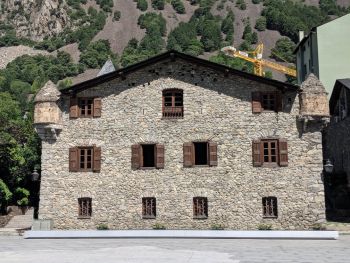Council of Regions of Anserisa (Pacifica)
| Council of Regions | |
|---|---|
| Concilio dem Regionalem | |
| Seating of the Council | |
| Overview | |
| Established | 7 September 1450 |
| Country | |
| Leader | Principal Councillor of Anserisa |
| Headquarters | Brantavilla, Anserisa |
| Seating | Socialist Union: 8 / 15 Republican Alliance: 4 / 15 Conservative Coalition: 3 / 15 |
The Council of Regions (Anserisan: Concilio dem Regionalem) is part of the legislative branch of the Republic of Anserisa. It is led by the Principal Councillor and it is part of the Congress of the Republic as the upper house. It is the oldest form of lawmaking in Anserisa, with its roots dating from the Council of Envoys.
The Council is responsible for the approval of the bills adopted by the National Convention and to approve the nominations made by the President of Anserisa, mainly the nominations made on the Republican Commission like the Vice-President and the Commissioners and all the judiciary, mostly the members of the Supreme Court of Justice.
Members
The Council is composed of 15 Councillors elected for mandates of 6 years. There are 5 Councillors for each of the three islands of Anserisa. The Councillors are elected by a regional proportional voting system. They are automatically members of the Congress of the Republic. They hold the right to use the post-nominal letters MCR for life.
Composition of the Council
| Island | Socialist | Republican | Conservative |
|---|---|---|---|
| Branta | Roméo Quensum Assunça Costum Reynaldo Cabrum |
Albo Christianum | Claudio Ménouarium |
| Haliétusa | Camilla Bonapartum Baptisto Bertrum |
Émiliana Clémençum Prospero Plessium |
Zéphyrino Massium |
| Rubecula | Magnuso Iousium Heloisa Macaum Dominico Ésenhorium |
Filomena Passum | Eustaquio Noronhum |
Principal Councillor
According to the Constitution,[1] the Principal Councillor is responsible for the agenda of the Council and can assemble into a caucus of members to establish the agenda. Normally, the Principal Councillor will consult with the General Representative to establish the common agenda of the two houses of Congress but when the two are members of opposing parties such collaboration is not necessarily followed.
Speaker of the Council
The Speaker of the Council is responsible for the application of the rules of the Council. It is also the de facto Acting-President of the Congress, along with the Deputy-President of the Congress, the Chair of the National Convention
Counter Councillor
The Constitution provides for a Councillor to become the Counter Councillor with powers to establish a caucus of members and to submit motions of censures against the caucus of the Principal Councillor.
Powers and functions
The Council has powers over the approval of the bills adopted by the National Convention. It can adopt amendments to bills and send the bill back to the Convention for a second reading. A bill needs the approval of the Council before being sent to the President for the proclamation into law. The Council also has powers over the nominations made by the President and can reject a nomination made by the President.
De facto all the Councillors are also members of the Congress of the Republic and thus can also execute those powers.
Council of Envoys Manor

The sittings of the Council happen in the same building that was housing the Council of Envoys meetings since the Treaty of Envoys in 1387.
See also
- ↑ Constitution of Anserisa (1815). Office of the Legislative Documents of Anserisa, Brantavilla.